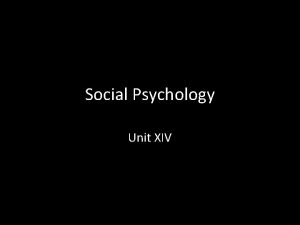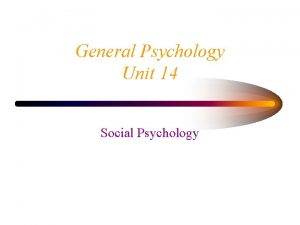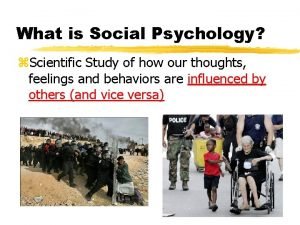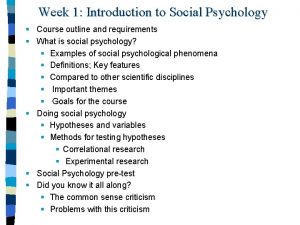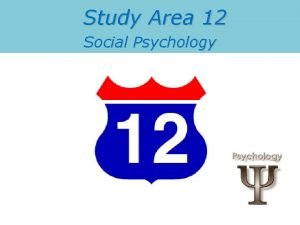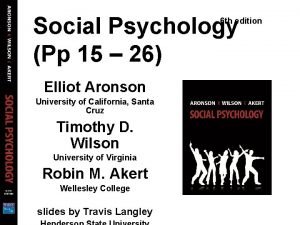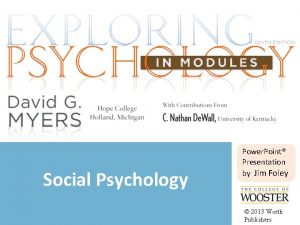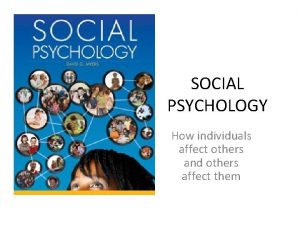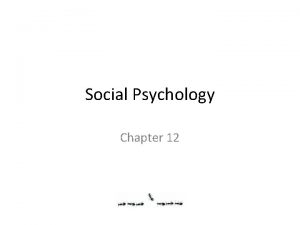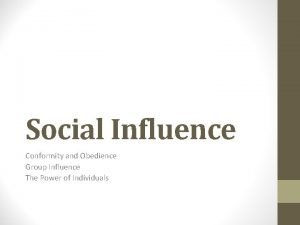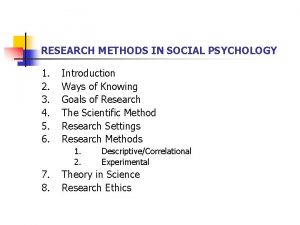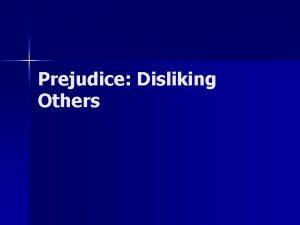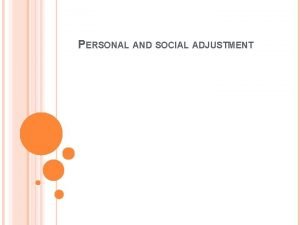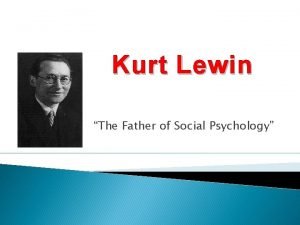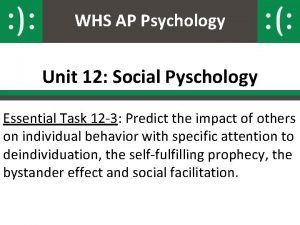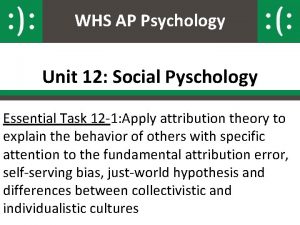WHS AP Psychology Unit 12 Social Psychology Essential
























![Reign of Prejudice works at the conscious and [more at] the unconscious level. Therefore, Reign of Prejudice works at the conscious and [more at] the unconscious level. Therefore,](https://slidetodoc.com/presentation_image_h/36f50fb7bd500133ee134a316c808f14/image-25.jpg)






![Emotional Roots of Prejudice provides an outlet for anger [emotion] by providing someone to Emotional Roots of Prejudice provides an outlet for anger [emotion] by providing someone to](https://slidetodoc.com/presentation_image_h/36f50fb7bd500133ee134a316c808f14/image-32.jpg)




- Slides: 36

WHS AP Psychology Unit 12: Social Psychology Essential Task 12 -5: Describe processes that contribute to differential treatment of group members with specific attention to attraction, altruism, aggression, in-group/outgroup dynamics, ethnocentrism, prejudice.

Fundamental Attribution Error Self-Serving Bias Attribution Individualistic vs. Collectivistic Culture Cognitive Dissonance Attitudes and Persuasion Routes to Persuasion We are here Just-World Hypothesis Unit 12: Social Psychology Impact of Others on You Conformity Schema Attraction In-Group/Out -Group Behavior Compliance Group Polarization Group Think

Essential Task 12 -5: Outline In group bias Treatment of Group Members Out group bias Attraction Altruism Ethnocentrism Proximity Intimacy Exchange Similarity Physical Attractiveness

Interpersonal Attraction is closely linked to 1. 2. 3. 4. 5. Proximity Physical attractiveness Similarity Exchange Intimacy

Psychology of Attraction 1. Proximity: Geographic nearness is a powerful predictor of friendship. Repeated exposure to novel stimuli increases their attraction (mere exposure effect). Rex USA A rare white penguin born in a zoo was accepted after 3 weeks by other penguins just due to proximity.

Proximity leads to liking • Moreland & Beach, 1992 • IV: Four female confederates attended large class 0, 5, 10, or 15 times • DV: How much liked slides of confederate at end of semester • Results: The more times confederate attended the class, the more she was liked.

Proximity leads to liking

Psychology of Attraction 2. Physical Attractiveness: Once proximity affords contact, the next most important thing in attraction is physical appearance. • Hatfield et al. (1966) • Couples randomly paired at “computer dance” • Assessed personality, aptitude, physical attractiveness • Results: Only physical attractiveness predicted liking and wanting to see the person again. (True for men and women. )

Physical attractiveness • • • Bias to like children who are attractive Dion (1972) IV: mild vs. severe misbehavior IV: attractive or unattractive photo of child DV: Rate typicality of behavior Results: Severe misbehavior rated more typical when performed by an ______child than an _____child.


Is attractiveness objective? • Arguments for Objective Standard • High consensus across countries, race/ethnicities – Agree on attractiveness of faces and body types (F: hourglass; M: v-shaped) • Particular features are associated with attractiveness – F: large eyes, prominent cheekbones, small nose, wide smile – M: broad jaw, large eyes, prominent cheekbones, wide smile • Babies look longer at faces rated as attractive by adults. (less likely to be affected by cultural standards

Is attractiveness subjective? • Arguments for Subjective Standard • Cross-cultural differences in ways to look beautiful – Face painting, plastic surgery, scarring, piercings, etc. – Variations in preference for female body size

Subjective? • Standards of beauty within a culture change over time – Marilyn Monroe versus Gwenyth Paltrow

Attractiveness Standards • Probably both universal and variable components of attractiveness • Overall, physical attractiveness predicts more positive evaluations (true in childhood and later in life)

Psychology of Attraction 3. Similarity: Similar views among individuals causes the bond of attraction to strengthen. § § § Finding others who agree with us strengthens our convictions and boosts our self-esteem Opposites don’t attract – they don’t even meet Complementary Traits – you complete me

Psychology of Attraction • 4. Exchange: The give and take of a relationship. • Social Exchange theory explains how we feel about a relationship with another person as depending on our perceptions of: – The balance between what we put into the relationship and what we get out of it. – The kind of relationship we deserve. – Contrast Effect – seeing something ‘better’ makes us temporarily devalue what we’ve got

Psychology of Attraction 5. Intimacy: closeness and trust achieved through communication • Must be mutual • Can’t be too much too soon

Pairing Game • Matching Hypothesis or Similarity Principle • Contrast Effect • Social Exchange Theory • Commitment can override the preference for alternatives.

Matching in physical attractiveness • People tend to pair with partners who are about as physically attractive as they are. • Predicts success of relationship (more similar in attractiveness, more likely to stay together) • However, women who marry less attractive men are shown to rate their marriage as more satisfying.

In-group bias Outline • In Group bias is a simple, but powerful concept. It is the tendency to favor one’s own group. Not one particular group, but whatever group you are associated with at that particular time. • If we believe someone else is in the same group to which we belong, we will have positive views of them. • We build our self esteem through belonging, and the presence of someone from the same group reminds of us belonging. • Ex: You side with the sports team that you like.

Out-group bias • When we categorize people as being part of our own group, they are part of our "in-group"; while others are part of the "out-group“. • We view members of the out-group as less similar causing us to have biases against them. Therefore, the out-group bias includes negative views about people that aren't in our in-group. • Example: Celtics fans hate Lebron, because he is not on the Celtics.

Altruism: • Altruism is the unselfish behaviors or actions done for someone else. • Example: if you volunteer at a nursing home, you are helping someone else without receiving any benefits.

Ethnocentrism • Ethnocentrism is a belief that your society, group, or culture is superior to others. • This can mean that differences in groups are seen as somehow bad. • Example: ‘Merica Mexican Border

Prejudice Simply called “prejudgment, ” a prejudice is an unjustifiable (usually negative) attitude toward a group and its members. Prejudice is often directed towards different cultural, ethnic, or gender groups. • • • Components of Prejudice Beliefs (stereotypes) Emotions (hostility, envy, fear) Predisposition to act (discrimination)
![Reign of Prejudice works at the conscious and more at the unconscious level Therefore Reign of Prejudice works at the conscious and [more at] the unconscious level. Therefore,](https://slidetodoc.com/presentation_image_h/36f50fb7bd500133ee134a316c808f14/image-25.jpg)
Reign of Prejudice works at the conscious and [more at] the unconscious level. Therefore, prejudice is more like a knee-jerk response than a conscious decision.

How Prejudiced are People? Over the duration of time many prejudices against interracial marriage, gender, homosexuality, and minorities have decreased.

Racial & Gender Prejudice Americans today express much less racial and gender prejudice, but prejudices still exist.

Race Nine out of ten white respondents were slow when responding to words like “peace” or “paradise” when they saw a black individual’s photo compared to a white individual’s photo (Hugenberg & Bodenhausen, 2003).

Social Roots of Prejudice Why does prejudice arise? 1. 2. 3. 4. Social Inequalities Social Divisions Emotional Scapegoating Need to categorize

Social Inequality Prejudice develops when people have money, power, and prestige, and others do not. Social inequality increases prejudice.

Social Divisions Ingroup: People with whom one shares a common identity. Outgroup: Those perceived as different from one’s ingroup. Ingroup Bias: The tendency to favor one’s own group. Mike Hewitt/ Getty Images Scotland’s famed “Tartan Army” fans.
![Emotional Roots of Prejudice provides an outlet for anger emotion by providing someone to Emotional Roots of Prejudice provides an outlet for anger [emotion] by providing someone to](https://slidetodoc.com/presentation_image_h/36f50fb7bd500133ee134a316c808f14/image-32.jpg)
Emotional Roots of Prejudice provides an outlet for anger [emotion] by providing someone to blame. After 9/11 many people lashed out against innocent Arab-Americans.

Cognitive Roots of Prejudice One way we simplify our world is to categorize. We categorize people into groups by stereotyping them. Michael S. Yamashita/ Woodfin Camp Associates Foreign sunbathers may think Balinese look alike.

Cognitive Roots of Prejudice In vivid cases such as the 9/11 attacks, terrorists can feed stereotypes or prejudices (terrorism). Most terrorists are non-Muslims.

Sources of Prejudice • Frustration-aggression theory – People who are frustrated in their goals may turn their anger away from the proper target toward another, less powerful target. (Scapegoat) • Authoritarian personality – Personality pattern characterized by rigid conventionality, exaggerated respect for authority, and hostility toward those who defy social norms • Racism – Prejudice and discrimination directed at particular racial group

We shall overcome • • • Recategorize – expand a schema to see how it relates to others. Not protestant vs. Catholic but instead both under Christianity. Controlled Processing – purposefully putting on their shoes. Method to learn tolerance Increase contact between groups. – – Equal status One-on-one contact Come together to cooperate, not compete Should not be contrived
 Wwusd whs
Wwusd whs A random sample of 100 whs students
A random sample of 100 whs students Model whs act
Model whs act Swms definition
Swms definition Study whs
Study whs Characteristics of lipids
Characteristics of lipids Altruism
Altruism Social psychology ap psychology
Social psychology ap psychology Social psychology is the scientific study of:
Social psychology is the scientific study of: Social thinking and social influence
Social thinking and social influence Apa itu social thinking
Apa itu social thinking Unit xiv social psychology
Unit xiv social psychology Unit 14 reading guide social psychology
Unit 14 reading guide social psychology Module 74 ap psychology
Module 74 ap psychology Ap psychology unit 14
Ap psychology unit 14 Social thinking social influence social relations
Social thinking social influence social relations Unit 6 review questions
Unit 6 review questions Teaching tolerance
Teaching tolerance Essential group
Essential group Positive psychology ap psychology definition
Positive psychology ap psychology definition Nature and scope of psychology
Nature and scope of psychology Health psychology definition ap psychology
Health psychology definition ap psychology Social inhibition example
Social inhibition example Social psychology course outline
Social psychology course outline Informational influence
Informational influence Bystander effect vs diffusion of responsibility
Bystander effect vs diffusion of responsibility Social facilitation in sport
Social facilitation in sport Gestalt psychology founder
Gestalt psychology founder Social psychology presentation
Social psychology presentation Social psychology lecture
Social psychology lecture Is sociology social psychology
Is sociology social psychology Chapter 12 social psychology
Chapter 12 social psychology Normative social influence
Normative social influence Methods of social psychology
Methods of social psychology Nature and power of prejudice
Nature and power of prejudice Meaning of social adjustment
Meaning of social adjustment Kurt lewin background
Kurt lewin background











